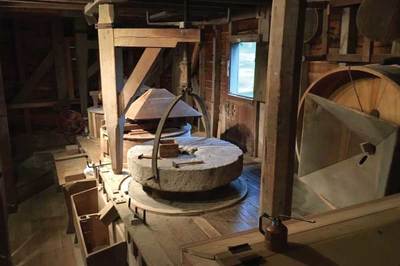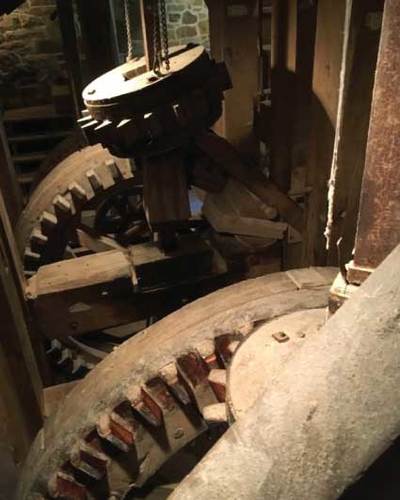|
By Joe Obidzinski Something that is often heard on a tour of the Blaker Gristmill at Jackson’s Mill is how much fun a job like ours would be to do day in and day out. This is very true, but often people do not understand just how much work goes into getting our mill ready to run. Here is just a brief snippet of some of the tasks necessary. Think of this as an episode of Mike Rowe’s Dirty Jobs, only without the trademark and host, and our subject being a 220+ year old machine that was disassembled from its original location in Greenbrier County and moved to its present location at Jackson’s Mill. Before we begin, we have to check all of the wooden gear teeth on the gears in the basement. On a regular basis, we check the main drive gear at the end of the crank shaft. The teeth there are held together by small wooden blocks putting pressure on the entire gear and holding everything in its proper place. So, from time to time, we use a small wooden mallet to hammer these back into place, tightening the gear teeth and ensuring that the gear does not fall apart. From here it is off to the large gear that drives the stone. Both this gear and the one we just left are given a coat of Crisco on each gear tooth. Why? This serves as lubricant for the teeth ensuring that they turn properly and do not wear down improperly. The loss of these teeth could result in your mill being down for a long period of time.
There is one final step before we leave the basement. The Blaker Mill is powered by one single crank shaft, all of which rests upon a number of large wooden cross beams. At each of these is a bearing that must be greased in order to turn properly. Once this is done, you can move upstairs to the main floor. We begin by removing the coverings and taking the plugs out of the chutes. Once this is done, you must assemble the furniture. In this case, “furniture” refers to the large pieces that are above the stones as they turn – the damsel (the large metal bar with ribs that turns as the stone turns), the horse (the large wooden frame that supports that large hopper on top, so named because it has four legs), and finally the hopper (which is where the corn or wheat goes). The damsel should also have a light coat of Crisco to help it turn more easily. You may be asking yourself, why do we use Crisco? The answer is that it used to be animal fat but the smell and the way it attracts other animals is why we have never used that at Jackson’s Mill. Once everything is completed, make sure that there is enough water in your mill pond, and enough corn in your hopper and you are ready to begin. Interested in seeing the Blaker Mill in action? Come out to Jackson’s Mill and take a tour of the grounds! A demonstration grind is the finishing touch to every tour. Comments are closed.
|
Preserve WV StoriesCategories
All
Archives
August 2023
|
Get Involved |
Programs |
Contact UsPreservation Alliance of West Virginia
421 Davis Avenue, #4 | Elkins, WV 26241 Email: [email protected] Phone: 304-345-6005 |
Organizational Partners:
© COPYRIGHT 2022 - PRESERVATION ALLIANCE OF WEST VIRGINIA. ALL RIGHTS RESERVED.





 RSS Feed
RSS Feed



